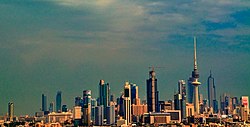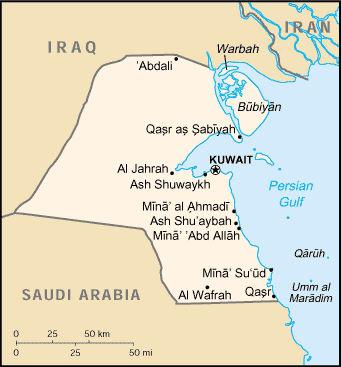Kuwait City
From Wikipedia, the free encyclopedia
| Kuwait City مدينة الكويت Madinat Al Kuwayt | |
|---|---|
| Kuwait City's skyline at night | |
| Coordinates: 29°22′11″N 47°58′42″E / 29.36972°N 47.97833°ECoordinates: 29°22′11″N 47°58′42″E / 29.36972°N 47.97833°E | |
| Country | Kuwait |
| Governorate | Al Asimah |
| Area | |
| - Metro | 200 km2 (77.2 sq mi) |
| Population (2005 estimate) | |
| - City | 96,100 |
| - Metro | 2,380,000 |
| Time zone | EAT (UTC+3) |
Kuwait City’s trade and transportation needs are served by Kuwait International Airport, Mina Al-Shuwaik (Shuwaik Port) and Mina al-Ahmadi (Ahmadi Port) 50 kilometers to the south, on the Persian Gulf coast.
Contents[hide] |
[edit] History
Kuwait City was first settled in the early 18th Century by the Al-Sabāh clan, later the ruling family of Kuwait and a branch of the Al-Utūb tribe (that also included the Al-Khalīfah clan, the ruling family of Bahrain), and their leader, Sheikh Sabāh I. Its name may have derived from an earlier abandoned fort located there, called "Kūt" (كوت) - Arabic for a fortress by the sea.The settlement grew quickly, and by the time its first wall was built (1760), the town had its own dhow fleet of about 800 and trading relations to Baghdad and Damascus. It was a successful and thriving sea port by the early 19th Century.
It was unclear whether or not Kuwait was part of the Ottoman Empire, and as a result, tensions often broke out between the sheikhdom and the empire. These tensions peaked when, in 1896, Sheikh Mubārak Al-Sabāh assassinated his brother, the emir Muhammad Al-Sabāh, over Mubārak's deep suspicion that the Ottoman Empire was willing to annex Kuwait.
In exchange for British naval protection, Mubārak was not to negotiate or give territory to any other foreign power without British consent. With the discovery of oil in 1936, the city’s standard of living improved dramatically, including health and education services.
On August 2, 1990, Iraqi forces seized the city and on August 8 they annexed the emirate. During the occupation, the city was extensively damaged and many buildings were destroyed after it, including the Kuwait National Museum.
After Iraqi forces retreated from Kuwait in January-February 1991, foreign investors and the Kuwaiti government were actively involved in modernizing the city and turning it into a world-class business hub. Many hotels, shopping malls and offices were built in the city indicating the economic growth since the war.

Kuwait City as seen from Shuwaikh.

An expressway in Kuwait City.
[edit] Suburbs
Main article: List of cities in Kuwait
Although the districts below are not usually recognized as suburbs, the following is a list of a few areas surrounding Kuwait city:
|
|
[edit] Economy
Kuwait’s booming economy has allowed many international hotel chains to enter agreements to open hotels in the country. According to the Kuwait Hotel Owners Association, over twenty-five new hotels are planned or in construction, including the following:- Golden Tulip Kuwait - opening late 2009
- Hotel Missoni Kuwait - opening late 2009
- Hilton Olympia Kuwait - opening late 2009
- Ibis Sharq - opening late 2009
- Jumeirah Messilah Beach Kuwait - opening early 2010
- InterContinental Kuwait Downtown - opening late 2010
- InterContinental Kuwait at The White - opening late 2010
- The Square Capital Tower - opening late 2011
- Novotel Mina Abdullah Resort - opening late 2011
- Four Seasons Hotel Kuwait at The Gate of Kuwait - plans are in motion to open within the next few years.
[edit] Climate
Kuwait City has an arid and hot temperature during summer. During winter temperatures are much cooler than summer. It can rain during winter at times but during summer, rain is unknown. The wettest month is January. During spring, the temperature start to warm up. Some rain is possible early, then comes summer. High temperatures range from 110-115 degrees. Dust storms occur at times during summer from the shamal wind.Dust storms can occur anytime of year but occur mostly during summer. During heatwaves temperatures can reach 125 degrees. During autumn temperature begin cool down and duststorms occur less. Some rain begins to appear during November and beyond.| [hide]Weather data for Kuwait City | |||||||||||||
|---|---|---|---|---|---|---|---|---|---|---|---|---|---|
| Month | Jan | Feb | Mar | Apr | May | Jun | Jul | Aug | Sep | Oct | Nov | Dec | Year |
| Average high °C (°F) | 18 (64) | 20 (68) | 25 (77) | 31 (88) | 38 (100) | 43 (109) | 44 (111) | 44 (111) | 41 (106) | 35 (95) | 27 (81) | 20 (68) | 32.2 (90) |
| Average low °C (°F) | 8 (46) | 10 (50) | 14 (57) | 19 (66) | 24 (75) | 28 (82) | 29 (84) | 29 (84) | 25 (77) | 21 (70) | 15 (59) | 9 (48) | 19.3 (67) |
| Precipitation mm (inches) | 24 (0.94) | 14 (0.55) | 14 (0.55) | 17 (0.67) | 3 (0.12) | 0 (0) | 0 (0) | 0 (0) | 0 (0) | 1 (0.04) | 16 (0.63) | 22 (0.87) | 111 (4.37) |
| Avg. rainy days | 7 | 5 | 5 | 4 | 1 | 0 | 0 | 0 | 0 | 1 | 3 | 5 | 31 |
| Source: Weather.com[1] January 6, 2009 | |||||||||||||










I jumped on an opportunity to purchase a rental property over the 4th of weekend. Mr Lee was quick to respond and since this was my first time getting a loan to buy a rental property , he was able to help me walk through the loan process. It was a great experience working with a good and kind loan lender Mr Lee. I hopefully know very well if you are looking for a loan to purchase a property or funding business purpose then Mr Lee will be able to help you with such a process here his details WhatsApp +1-989-394-3740. / 247officedept@gmail.com !”
ReplyDelete